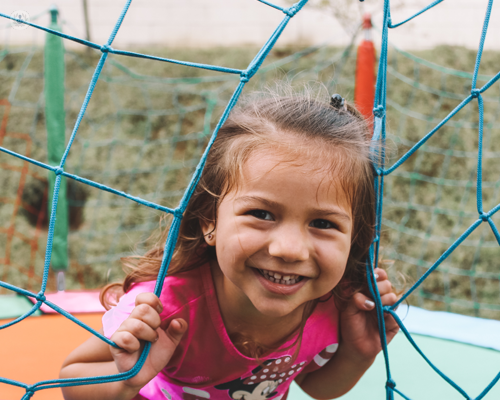Hernia treatment for children and babies
Written in association with:Hernias are common in children and babies and can occur due to a weakness in the abdominal wall muscles. Paediatric urologists often encounter questions from parents about hernia treatment for their little ones, and in this article leading paediatric surgeon and urologist Mrs Diane De Caluwe provides an in-depth overview of what's involved in hernia treatment for children and babies.

What is a hernia?
A hernia occurs when an organ, such as the intestines, protrudes through a weak spot or tear in the abdominal wall.
In children and babies, hernias commonly occur in the:
- inguinal area (groin);
- umbilical region (belly button), or;
- upper abdomen midline (epigastric hernia).
How is a hernia diagnosed in children and babies?
Your child's doctor will perform a thorough physical examination to assess for signs of a hernia.
They may feel for a bulge or swelling in the affected area, which may become more prominent when your child cries or strains.
In some cases, imaging tests such as ultrasound or MRI may be used to confirm the diagnosis and evaluate the extent of the hernia.
What are the treatment options for hernias in children and babies?
In some cases, particularly with umbilical hernias in infants, the hernia may close on its own without the need for intervention.
Your child's doctor may recommend monitoring the hernia and taking a wait-and-see approach. Groin hernias will always require surgery.
Surgical repair
If the hernia does not close on its own or if it poses a risk of complications, surgical repair may be recommended.
Hernia repair surgery is typically performed under general anaesthesia to ensure your child remains comfortable and pain-free during the procedure.
What happens during hernia repair surgery?
During the surgical procedure, the paediatric urologist will make a small incision near the site of the hernia.
The protruding organ or tissue will be gently pushed back into place, and the weakened area of the abdominal wall will be repaired with stitches.
After surgery, your child will be closely monitored in the recovery room until they are fully awake and stable.
Most children are able to return home the same day as the surgery, although they may need to avoid high energy activities for a few weeks while they heal.
What are the risks and benefits of hernia surgery for children and babies?
Risks
As with any surgical procedure, there are risks associated with hernia repair surgery, including infection, bleeding, and adverse reactions to anaesthesia.
However, these risks are rare, and the benefits of hernia surgery often outweigh the potential complications.
Benefits
Hernia repair surgery is highly effective in correcting the hernia and preventing complications such as strangulation, which can cut off blood flow to the affected organ and lead to tissue damage.
Do you want to find out more about hernia treatment for children and babies? Arrange a consultation with Mrs De Caluwe via her Top Doctors profile.


